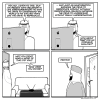In what may be the largest study ever conducted on changes in Americans’ religious involvement, researchers led by San Diego State University psychology professor Jean M. Twenge found that millennials are the least religious generation of the last six decades, and possibly in the nation’s history.
The researchers analyzed data from 11.2 million respondents from four nationally representative surveys of U.S. adolescents ages 13 to 18 taken between 1966 and 2014.
Recent adolescents are less likely to say that religion is important in their lives, report less approval of religious organizations, and report being less spiritual and spending less time praying or meditating.
Compared to the late 1970s, twice as many 12th graders and college students never attend religious services, and 75 percent more 12th graders say religion is “not important at all” in their lives. Compared to the early 1980s, twice as many high school seniors and three times as many college students in the 2010s answered "none" when asked their religion.
Compared to the 1990s, 20 percent fewer college students described themselves as above average in spirituality, suggesting that religion has not been replaced with spirituality.
“Unlike previous studies, ours is able to show that millennials’ lower religious involvement is due to cultural change, not to millennials being young and unsettled,” said coauthor Twenge.
Twenge JM, Exline JJ, Grubbs JB, Sastry R, Campbell WK. Generational and Time Period Differences in American Adolescents’ Religious Orientation, 1966-2014. PLoS ONE. 2015;10(5):e0121454. http://journals.plos.org/plosone/article?id=10.1371/journal.pone.0121454
In four large, nationally representative surveys (N = 11.2 million), American adolescents and emerging adults in the 2010s (Millennials) were significantly less religious than previous generations (Boomers, Generation X) at the same age.
The data are from the Monitoring the Future studies of 12th graders (1976–2013), 8th and 10th graders (1991–2013), and the American Freshman survey of entering college students (1966–2014).
Although the majority of adolescents and emerging adults are still religiously involved, twice as many 12th graders and college students, and 20%–40% more 8th and 10th graders, never attend religious services.
Twice as many 12th graders and entering college students in the 2010s (vs. the 1960s–70s) give their religious affiliation as “none,” as do 40%–50% more 8th and 10th graders.
Recent birth cohorts report less approval of religious organizations, are less likely to say that religion is important in their lives, report being less spiritual, and spend less time praying or meditating.
Thus, declines in religious orientation reach beyond affiliation to religious participation and religiosity, suggesting a movement toward secularism among a growing minority.
The declines are larger among girls, Whites, lower-SES individuals, and in the Northeastern U.S., very small among Blacks, and non-existent among political conservatives. Religious affiliation is lower in years with more income inequality, higher median family income, higher materialism, more positive self-views, and lower social support.
Overall, these results suggest that the lower religious orientation of Millennials is due to time period or generation, and not to age.












